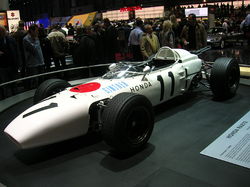Honda RA272
|
Honda RA272 |
|||||||||
| Constructor: |
|
||||||||
| Designer: | Tadashi Kume | ||||||||
| Predecessor: | Honda RA271 | ||||||||
| Successor: | Honda RA273 | ||||||||
| Technical specifications | |||||||||
|---|---|---|---|---|---|---|---|---|---|
| Chassis: | aluminum | ||||||||
| Wheelbase: | 2289 mm | ||||||||
| Weight: | 485 kg | ||||||||
| Tires: | Goodyear | ||||||||
| Petrol: | BP | ||||||||
| statistics | |||||||||
| Driver: |
|
||||||||
| First start: | 1965 Monaco Grand Prix | ||||||||
| Last start: | 1965 Mexican Grand Prix | ||||||||
|
|||||||||
| World Cup points: | 13 | ||||||||
| Podiums: | 1 | ||||||||
| Leadership laps: | 67 over 333.386 km | ||||||||
The Honda RA272 was a Formula 1 car made by the Japanese manufacturer Honda and entered service in 1965 . It was the successor to the Honda RA271 , the first Japanese car in Formula 1. It was the first Japanese car to win a Grand Prix.
engine
1965 was the last year of the 1.5-liter engines, and Honda had developed a twelve-cylinder engine that delivered 233 hp at 11,000 rpm, more power than a V12 Ferrari engine. It is considered the most powerful engine of the 1.5-liter era.
With the exception of Honda and Ferrari, all other racing teams used eight-cylinder engines. Another special feature is that the Honda engine was installed transversely in front of the rear axle. Together with the gearbox, it formed a unit with a common oil sump and a total weight of 215 kg.
The engine was developed from a 125 cm³ motorcycle engine. Two V-shaped cylinders (displacement 250 cm³, internally known as K005) delivered an output of 36 HP, so that a twelve-cylinder output of around 225 HP was expected. In addition, a twelve-cylinder (compared to an eight-cylinder) had lower moving masses and could achieve higher speeds.
Up to a speed of 13,000 rpm, the engine delivered its power in a usable manner; the red area on the tachometer began at 14,000 rpm. Ronnie Bucknum reports that he once accidentally turned the engine up to 16,000 rpm; the engine survived this.
The engine consisted of two units, each with its own cylinder heads. The power output with a spur gear was in the middle of the crankshaft, together with the camshaft drive. There were two camshafts and four valves per cylinder per cylinder head. The mixture was prepared in the RA271 with six double-flow Keihin downdraft gasifiers. During the development of the RA272, an injection system was used. 1 to 8 cubic millimeters per cylinder were required per cycle. To illustrate: 8 cubic millimeters corresponds roughly to the volume of a match head.
Different diameters were used for the crankshaft bearings: 40 mm next to the drive wheel, 36 or 33 and 30 mm progressing outwards. The inner connecting rod bearings also measured 32 mm, the outer 27 mm. The RA271 motor had a bearing to guide the output spur gear, which was omitted in the RA272.
All bearings of the crankshaft, the connecting rod and the camshaft were designed as roller or needle bearings .
Chassis and running gear
The front 75 percent of the frame was designed as an aluminum monocoque , a fairly new technology in 1965. The rear quarter carried the engine and the rear suspension with a conventional tubular space frame .
The front and rear suspension consisted of double wishbones . In 1965, Goodyear was the tire supplier. The 13 inch wheels were secured with central flapping wing nuts.
driver
The car was driven by Ronnie Bucknum and Richie Ginther .
successes
Richie Ginther achieved sixth place each at the Belgian Grand Prix and the Dutch Grand Prix , 14th place at the Italian Grand Prix , seventh place at the US Grand Prix and victory at the Mexican Grand Prix .
Ronnie Bucknum finished 13th in the US and fifth in Mexico. The successes were generally attributed to the enormous acceleration that was caused by the engine power. The chassis was not considered the best of the time.
Predecessor and successor
The predecessor, the Honda RA271, was the first Japanese car in Formula 1. It weighed 25 kg more than the 272 and ran on Dunlop tires. The successor was the Honda RA273 , the engine of which corresponded to the new displacement formula of 3000 cm³ and was installed lengthways.
Three units of the 272 model were built, one of which was destroyed during test drives in Suzuka .
Web links
Individual evidence
- ↑ for almost the whole article: Karl Ludvigsen "Honda RA272-V12" in: Automobilsport-magazin # 02 2014
- ^ Mark Whitelock: 1 1/2-liter Grand Prix Racing. Veloce Publishing Ltd, 2006, ISBN 978-1-845-84016-7 , p. 253 ( limited preview in Google book search).
